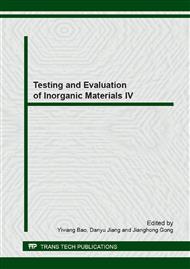[1]
J.E.G. Gonzalez, J.C. Mirza-Rosca, Study of the corrosion behavior of titanium and some of its alloys for biomedical and dental implant applications, J. Electroanal. Chem. 471(2) (1999) 109-115.
DOI: 10.1016/s0022-0728(99)00260-0
Google Scholar
[2]
J. Pan, D. Thierry, C. Leygraf, Electrochemical impedance spectroscopy study of the passive oxide film on titanium for implant application, Electrochim. Acta. 41(7-8) (1996) 1143-1153.
DOI: 10.1016/0013-4686(95)00465-3
Google Scholar
[3]
K. Wang, The use of titanium for medical applications in USA, Mater. Sci. Eng. A213 (1996) 134-137.
Google Scholar
[4]
Z.F. Zhu: Corrosion resistance and Applications of Nonferrous Metals, Chemical Industry Press, Beijing, (1999).
Google Scholar
[5]
H. -D. Steffens, M. Mack, Plasma spraying as an advanced tool in surface engineering, Pure Appl. Chem. 62(9) (1990) 1801-1808.
DOI: 10.1351/pac199062091801
Google Scholar
[6]
Y.C. Zhu, C.X. Ding, Characterization of plasma sprayed nano-titania coatings by impedance spectroscopy, J. Eur. Ceram. Soc. 20 (2000) 127-132.
DOI: 10.1016/s0955-2219(99)00159-4
Google Scholar
[7]
Y. Fan, Y. Yin, Corrosion behaviors of TiO2 coated by plasma spraying in seawater, Int. Ceram. Rev. 55 (2006) 426-430.
Google Scholar
[8]
Y.S. Song, I.G. Lee, S.N. Hong, S. Kim, K.H. Lee, D.Y. Lee, Corrosion properties of plasma-sprayed Al2O3-TiO2 coatings on Ti metal, J. Mater. Sci. 41 (2006) 2059-(2065).
DOI: 10.1007/s10853-006-4506-6
Google Scholar
[9]
F.A. Bonilla, T.S. Ong, P. Skeldon, et al., Enhanced corrosion resistance of titanium foil from nickel, nickel–molybdenum and palladium surface alloying by high intensity pulsed plasmas, Corros. Sci. 45(2) (2003) 403-412.
DOI: 10.1016/s0010-938x(02)00125-7
Google Scholar
[10]
Z.Y. He, Z.X. Wang, W.B. Wang, A.L. Fan, Z. Xu, Surface modification of titanium alloy Ti6Al4V by plasma niobium alloying process, Surf. Coat. Tech. 201 (2007) 5705-5709.
DOI: 10.1016/j.surfcoat.2006.07.061
Google Scholar
[11]
G.J. Wan, N. Huang, Y.X. Leng, et al., TiN and Ti-O/TiN films fabricated by PIII-D for enhancement of corrosion and wear resistance of Ti-6Al-4V, Surf. Coat. Tech. 186 (2004) 136-140.
DOI: 10.1016/j.surfcoat.2004.04.037
Google Scholar
[12]
J.B. Wu, Y.W. Tsai, C.T. Shih, M.Y. Li, M.S. Leu, C.C. Lai, Corrosion resistance of TiN coatings prepared by filtered cathodic vacuum arc process, MRS Proc. 885 (2006) 191-196.
DOI: 10.1557/proc-0885-a09-07
Google Scholar
[13]
M. Balaceanu, V. Braic, M. Braic, A. Kiss, C.N. Zoita, A. Vladescu, P. Drob, C. Vasilescu, D. Dudu, O. Muresanu, Structural, mechanical and corrosion properties of TiOxNy/ZrOxNy multilayer, Surf. Coat. Tech. 202(11) (2008) 2384-2388.
DOI: 10.1016/j.surfcoat.2007.09.032
Google Scholar
[14]
Y.X. Leng, J.Y. Chen, P. Yang, et al., The microstructure and properties of titanium dioxide films synthesized by unbalanced magnetron sputtering, Nucl. Instrum. Meth. B. 257 (2007) 451-454.
DOI: 10.1016/j.nimb.2007.01.096
Google Scholar
[15]
A.V. Kasatkin, L.P. Kornienko, et al., Electrochemical and corrosion behavior of titanium with vacuum-deposited molybdenum coating, Prot. Met. (Prot. Met. Phys. Chem. ) 34 (1998) 15-18.
Google Scholar
[16]
V.V. Malyshev, A.I. Hab, Electrochemical and corrosion behavior of titanium with molybdenum-carbide coatings in solutions of sulfuric acid, Mater. Sci. 39(6) (2003) 901-903.
DOI: 10.1023/b:masc.0000031658.75261.5f
Google Scholar
[17]
X.P. Jiang, X.Y. Wang, J.X. Li, D.Y. Li, C. -S. Man, M.J. Shepard, T. Zhai, Enhancement of fatigue and corrosion properties of pure Ti by sandblasting, Mat. Sci. Eng. A 429(1-2) (2006) 30-35.
DOI: 10.1016/j.msea.2006.04.024
Google Scholar


